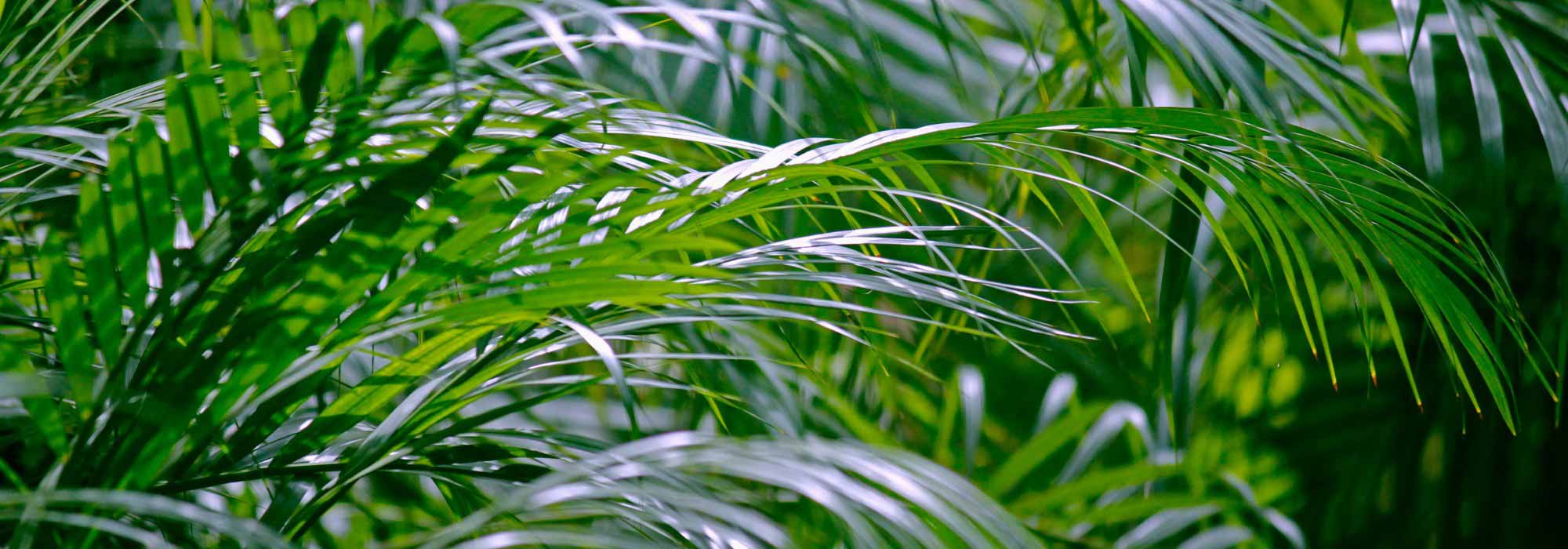
Areca: cultivation, planting and maintenance of this indoor palm
Contents
Areca in a nutshell
- Areca is an elegant and easy-to-care-for indoor palm
- It is valued for its lush foliage and rapid growth
- Its long, slightly arching pinnate leaves are a bright green
- It is relatively easy to maintain, requiring bright indirect light, ambient humidity, and regular watering
- It helps to purify the surrounding air and improves indoor air quality
A word from our expert
Areca is undoubtedly the most popular indoor palm! Its graceful appearance and lush foliage make it an ideal choice for adding a touch of exoticism to our interiors. However, the plant found under this name in garden centres is actually Dypsis lutescens, often referred to as “Areca” by misnomer. This palm, appreciated for its long, arching leaves of vibrant green and rapid growth, is easy to cultivate and adapts well to indoor life with bright indirect light, a bit of humidity, and regular watering.
Undemanding and renowned for its ability to purify the air, Areca – or rather Dypsis lutescens – has become a staple of modern interiors, whether in a living room, an entrance hall, an office, or even a bright bathroom. It immediately brings a sense of freshness and tropical escape.
Discover all our tips for successfully growing, planting, and caring for this essential indoor palm!
Botany
Botanical data
- Latin name Areca
- Family Arecaceae
- Common name Areca, Areca Palm, Golden Palm, Bamboo Palm, Multiplying Palm
- Flowering In spring or summer, rarely indoors
- Height 2 to 3 metres indoors, up to 10 metres in its natural habitat
- Exposure Bright
- Soil type Light, rich and well-drained
- Hardiness Frost-sensitive (USDA zones 10 to 12)
The plant commonly known as ‘Areca’ indoors is actually Dypsis lutescens, a palm highly valued for its light foliage and graceful habit. However, although this commercial name is widely used, it is not a true Areca in the botanical sense.
Areca is a commonly used name that actually refers to Dypsis lutescens, a palm highly appreciated indoors. The Dypsis, closely related to Areca, are indoor palms that we love for their slender appearance and finely cut foliage. Yet, this designation is botanically incorrect, as Dypsis lutescens does not belong to the genus Areca, although it is part of the same family of Arecaceae, which includes tropical and subtropical palms. This confusion originates from the commercial use of the term “Areca,” which has become common parlance, as well as the morphological resemblance between Dypsis lutescens and certain palms of the genus Areca. Historically, botanical classifications have also evolved, contributing to the ambiguity.
In reality, Dypsis lutescens, native to Madagascar, is distinguished by its multiple stems and rapid growth, making it suitable for indoor cultivation. True Areca, such as Areca catechu, are less common indoors and have more tropical cultivation requirements. Thus, even though the name “Areca” remains widely used, it is more accurate to refer to Dypsis lutescens when designating this popular indoor palm.
The true genus Areca comprises about 50 to 60 species of tropical palms, primarily native to Southeast Asia and the Pacific Islands. These palms naturally grow in humid tropical forests, particularly in India and extending to the Pacific Islands. They thrive in warm, humid climates, evolving in shaded and well-drained environments, where heat and humidity promote their lush development. The genus Areca (true Areca) includes species such as Areca catechu, the betel palm, which is especially known for its seeds used in traditional medicine and for chewing in Asia. There is also Areca triandra (Three-stamen Areca), which is more compact, suckers at the base, and is somewhat more suitable for indoor cultivation, and Areca vestiaria (Orange Areca), very decorative with its bright orange stipes, but requiring high humidity. The “true” Areca are less frequent indoors as they require more tropical conditions. Unlike Dypsis lutescens, which adapts well to our interiors, true Areca are more demanding and are mostly found in tropical environments.
These species are more demanding than Dypsis lutescens, which explains why the latter has become the quintessential indoor palm, even though its scientific name is not Areca.
In the tropics, Dypsis lutescens is nicknamed “Multiplying Palm” due to its ability to produce numerous suckers that form a dense clump. Its slender, golden stipes bear long, arching leaves of bright green, which also earns it the nickname “Bamboo Palm”. This palm is appealing for its elegant habit and ease of cultivation, which explains why it is widely marketed under the name “Areca” for indoor cultivation.
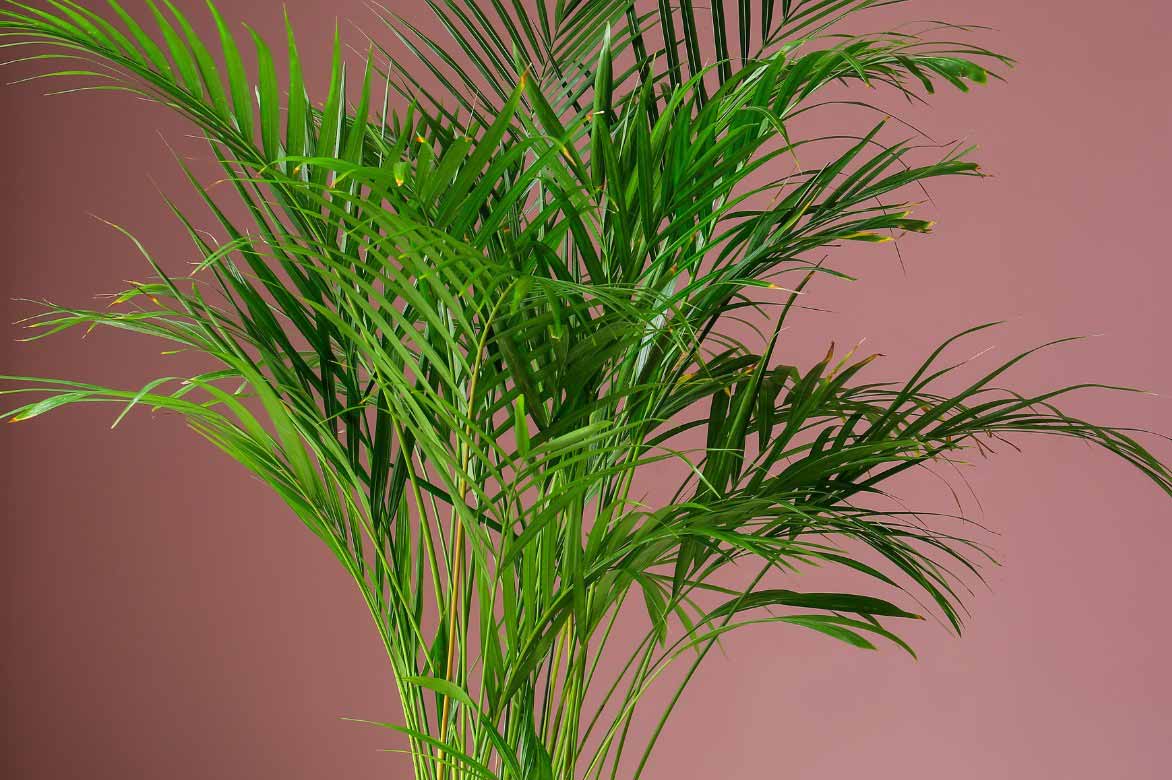 The Areca features large, finely cut leaves attached to slender, light green to pale yellow stipes.
The Areca features large, finely cut leaves attached to slender, light green to pale yellow stipes.
The Areca is distinguished by its elegant and graceful appearance. It typically forms a clump of several slender (trunks) smooth stipes, light green to yellowish in colour. These stipes resemble bamboo stems, which sometimes earns it the nickname “Bamboo Palm.” The Areca naturally produces suckers at the base of its stipes. These suckers are young shoots that emerge from the base of the plant and contribute to its bushy and dense habit. The Areca can reach up to 10 m in height in the wild. It will maintain much more modest dimensions in a pot, not exceeding 2 to 3 m in height.
Its root system is fasciculate, composed of many fine, small roots that spread horizontally near the surface. This dense network ensures good stability and facilitates rapid water absorption, but it remains shallow, making the plant sensitive to excess water.
The foliage of the Areca is characteristic of the species. It consists of long pinnate leaves, slightly arching and a bright green. These leaves, supported by a central rachis, are divided into numerous narrow and regular pinnules. These leaves can measure up to two metres long. They grow in a tuft at the top of the stipes, accentuating the feathery and lush appearance of the plant.
Indoors, it is rare to see it flower. However, in its natural habitat or when cultivated under optimal conditions, the Areca produces clusters of small, inconspicuous flowers, cream to pale yellow in colour. These flowers are grouped in panicles that emerge at the axil of the leaves. In some species like Areca catechu, these flowers later develop into oval fruits, orange to red when ripe, containing the famous betel nuts. However, in indoor cultivation, the Areca rarely flowers, as it requires conditions very close to its natural habitat to develop its inflorescences.
The Areca is known for its ability to purify the ambient air by absorbing certain toxins present in our interiors. It is a true ally for improving air quality. Studies, including those conducted by NASA on air-purifying plants, have shown that certain indoor plants, including Areca (Dypsis lutescens), can absorb atmospheric pollutants such as formaldehyde, xylene, and toluene, which are present in our homes and offices.
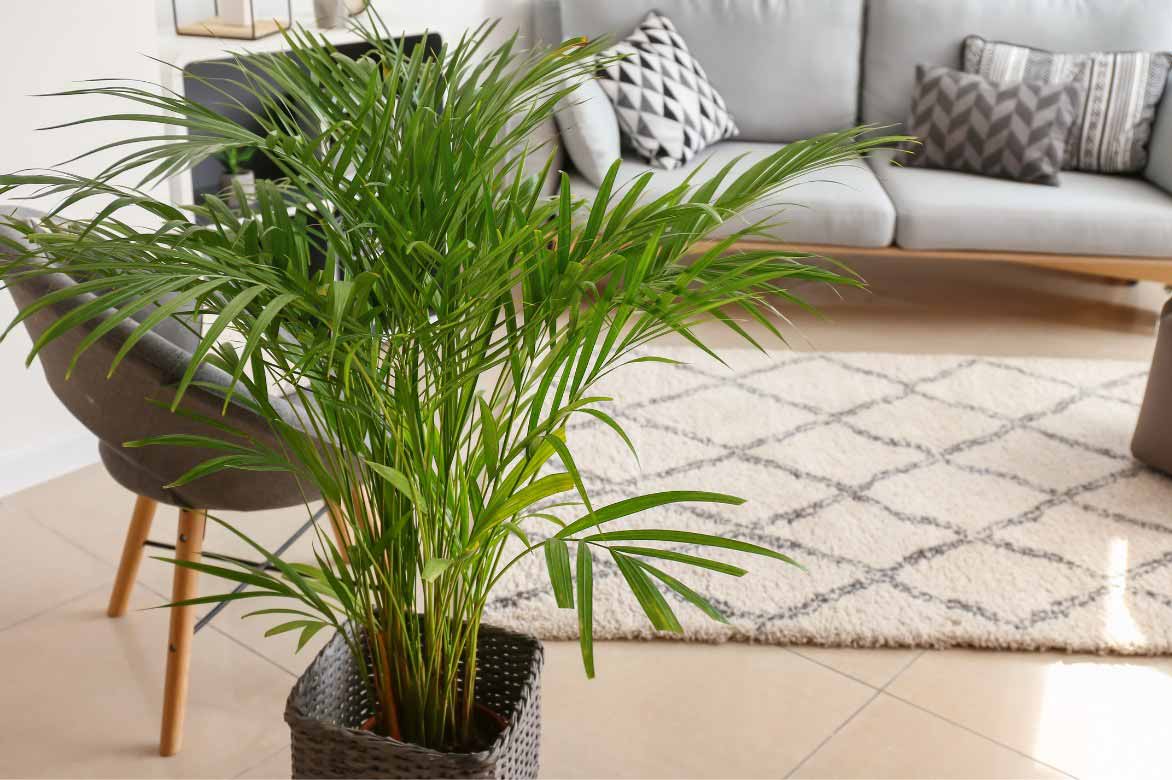 The Areca brings a very graphic atmosphere to our interiors, in addition to purifying the air!
The Areca brings a very graphic atmosphere to our interiors, in addition to purifying the air!
Planting the Areca
Where to place an Areca?
The Areca loves warm and bright environments, making it an ideal plant for indoors. In nature, however, it has developed an astonishing ability to thrive in low light conditions, allowing it to flourish in places where other plants would struggle. To install it properly, choose a bright location, but without direct sunlight, as its delicate leaves could burn. A room with filtered light, a spot near a veiled east or north-east facing window, will suit it perfectly. Avoid drafts and areas that are too cold, as it prefers temperatures between 18 and 24 °C.
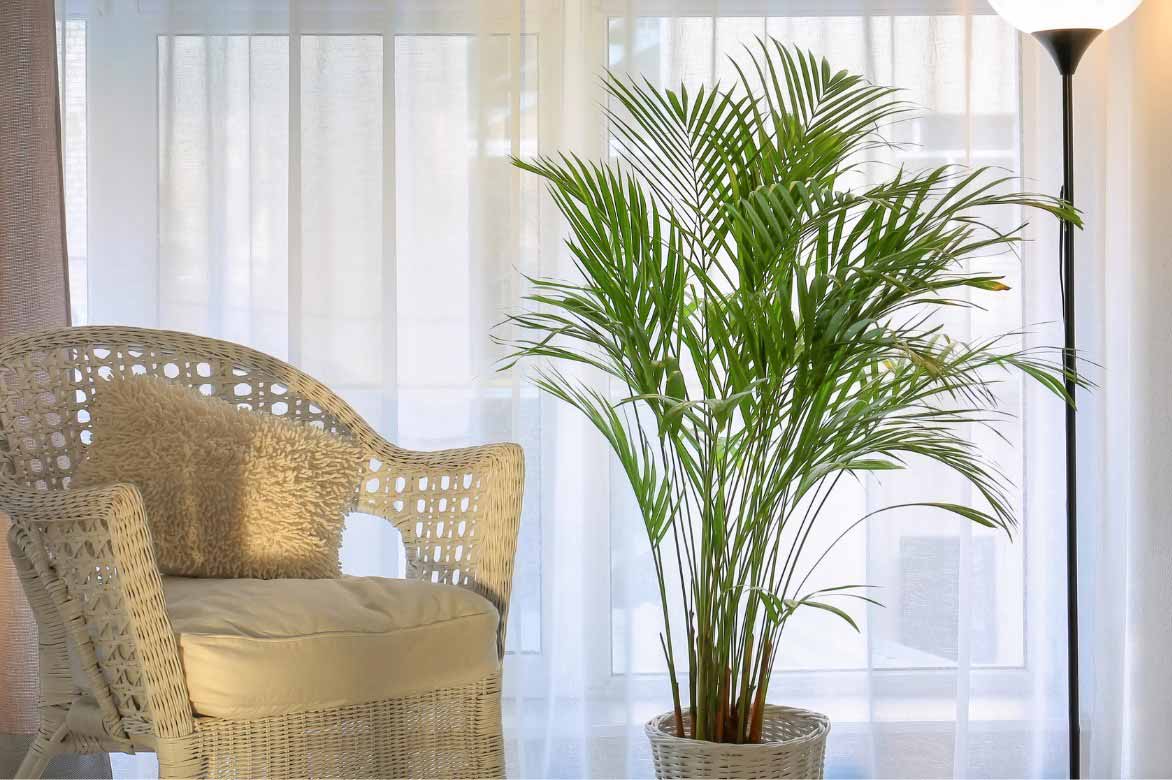
The ideal is to place the Areca in a bright location but sheltered from direct sunlight, for example behind a window or a veiled bay window
When to plant an indoor Areca?
The ideal time to plant or repot the Areca is spring, to set it up in optimal conditions for its growth period. However, it is possible to plant it all year round.
How to plant the Areca step by step?
Ensure that the substrate is light and airy to allow the roots to breathe. This tropical palm appreciates bright, warm, and well-drained environments.
- Choose a pot or container with drainage holes, slightly larger than the size of the root ball, to allow the roots to develop well.
- Place a drainage layer at the bottom of the pot with clay balls, gravel, or broken pieces of terracotta pots. This will prevent excess water that can cause root rot.
- Gently plant your Areca in a mixture composed of 50% loamy soil, 25% potting soil or humus, and 25% sand, or choose a light potting soil for indoor plants.
- Ensure that the collar (the transition zone between the roots and the stems) is level with the soil. It should not be too buried or too exposed.
- Add the rest of the mixture around the root ball and lightly compact it to stabilise the plant.
- Water in several stages to thoroughly moisten the entire substrate and eliminate air pockets.
- Place your Areca in a bright location, but without direct sunlight that could burn its leaves. A room with filtered light will be ideal.
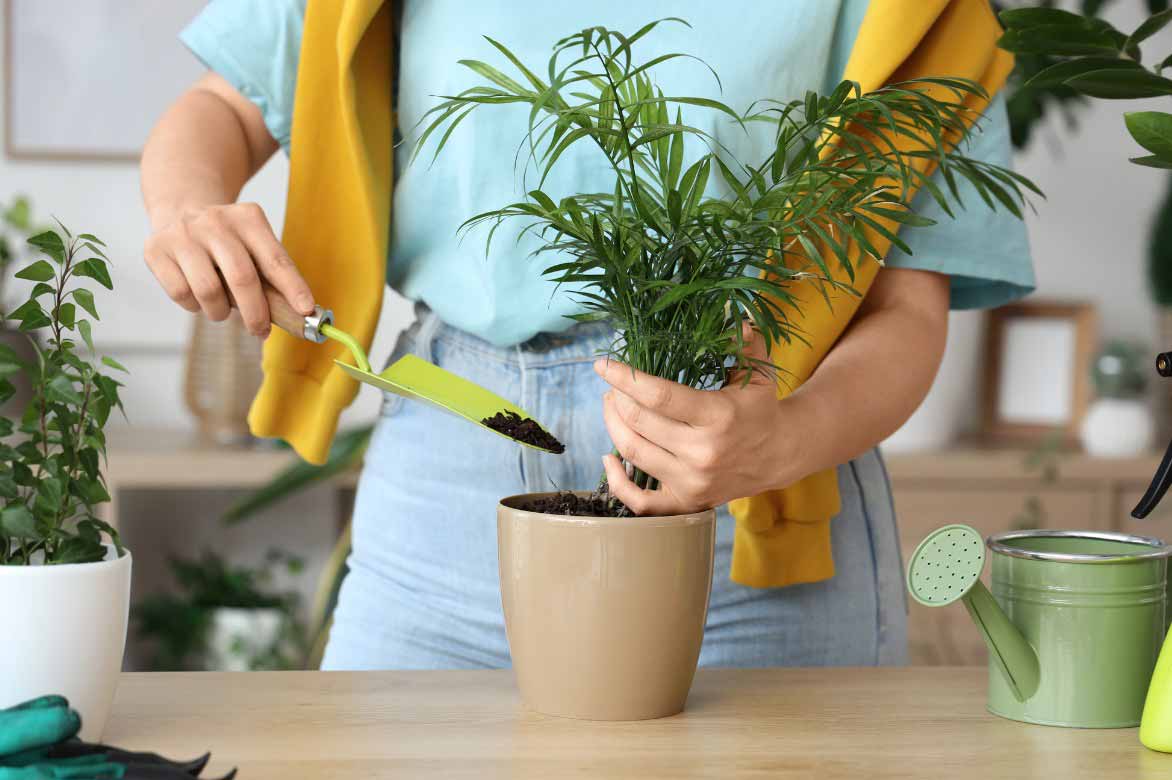 Choose a pot suitable for the size of your Areca, slightly larger than the root ball
Choose a pot suitable for the size of your Areca, slightly larger than the root ball
How to care for a multiplying palm tree?
Caring for Areca is quite simple, making it an ideal plant for indoors. Areca enjoys humidity but is sensitive to excess water. Therefore, it is essential to find the right medium. Water regularly with non-lime water, but allow the substrate to dry slightly on the surface between waterings. In summer, water requirements are greater than in winter. To check if your Areca needs water, insert your finger into the potting medium: if it is dry a few centimetres down, it’s time to water.
Native to tropical forests, Areca thrives in a humid environment. Regularly mist its leaves with non-lime water, especially in winter when heating dries the air. You can also place the pot on a bed of moistened clay balls.
Areca does not require regular pruning. You can simply remove dry or damaged leaves using disinfected pruning shears.
During the growth period, which is in spring and summer, provide your Areca with a special palm fertiliser once a month.
Repot it every 2 to 3 years into a slightly larger pot, preferably in spring, when its roots start to feel cramped.
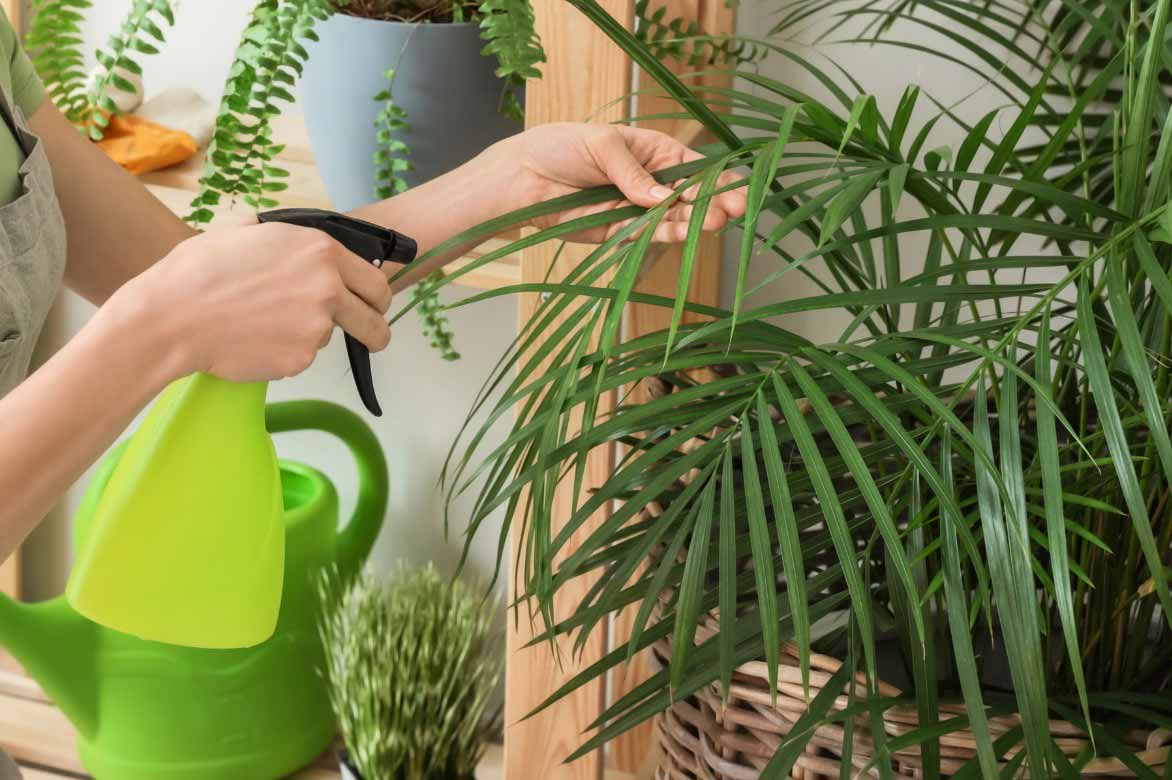
Areca will appreciate it if you mist its foliage from time to time
Diseases and potential pests
Areca is relatively resistant to diseases and pests. However, it can be sensitive to root rot caused by excess water or poor drainage. This leads to yellowing of the leaves and wilting of the plant. Reduce watering, check that the pot is well-drained, and repot with healthy potting soil if necessary.
It can also be attacked by scale insects or spider mites in case of excessively dry air. Increase the ambient humidity around your Areca by regularly misting it with water, as scale insects and spider mites dislike humidity. Clean the leaves with a cloth soaked in soapy water or 70°C alcohol, and treat with a natural insecticide (neem oil).
→ Read our articles to learn more about suitable treatments for scale insects and spider mites.
Multiplication of Areca
Suckers can be left in place to keep a plant well-furnished, or taken in spring to propagate the plant. To do this, simply wait until a sucker is well-developed, with some roots. As it does not fruit in our latitudes, taking suckers is the most suitable technique. It is important not to remove too many suckers at once so as not to weaken the mother plant.
- Using a sharp, disinfected knife, separate the suckers from the mother plant, taking care not to damage the roots. Each sucker should have some roots.
- Plant each sucker in an individual pot filled with fresh, well-drained potting soil.
- Water generously to encourage recovery.
Areca: the trendy indoor plant!
Areca is a true decorative asset thanks to its light and elegant foliage that brings a tropical and soothing touch to any interior. Its graceful habit and airy silhouette allow it to harmoniously integrate into various decoration styles.
What type of interior is suitable for Areca?
- Bohème style: With its feathery leaves and natural look, Areca perfectly fits into a bohemian decor, surrounded by natural materials such as rattan, linen, or macramé.
- Tropical/urban jungle style: It is the ideal plant for creating an exotic corner by combining it with other green plants like Monstera, Philodendron, or Kentia palm.
- Contemporary and minimalist style: In a clean interior, Areca adds a touch of greenery without overwhelming the space thanks to its light and slender habit.
- Office: Areca is often used in offices or entrance halls to create a welcoming and relaxed atmosphere.
Useful resources
Frequently asked questions
-
Pourquoi areca leaves dry out?
Dry ambient air is one of the most common causes. The Areca, native to tropical regions, thrives in a humid environment. Central heating in winter or a location too far from a moisture source can dry out the air, causing the tips of the leaves to turn brown and dry out. Solution: Mist its leaves with non-limestone water 2 to 3 times a week. You can also place a humidifier or set the pot on a bed of clay balls with water.
Inappropriate watering can also be a factor. Excess water leads to root rot and causes the leaves to yellow and then dry out. Conversely, a lack of water results in wilting and browning of the leaves. A lack of light can slow the growth of your Areca and cause the lower leaves to yellow and then dry out. However, avoid direct sunlight exposure, which could scorch the foliage.
- Subscribe!
- Contents
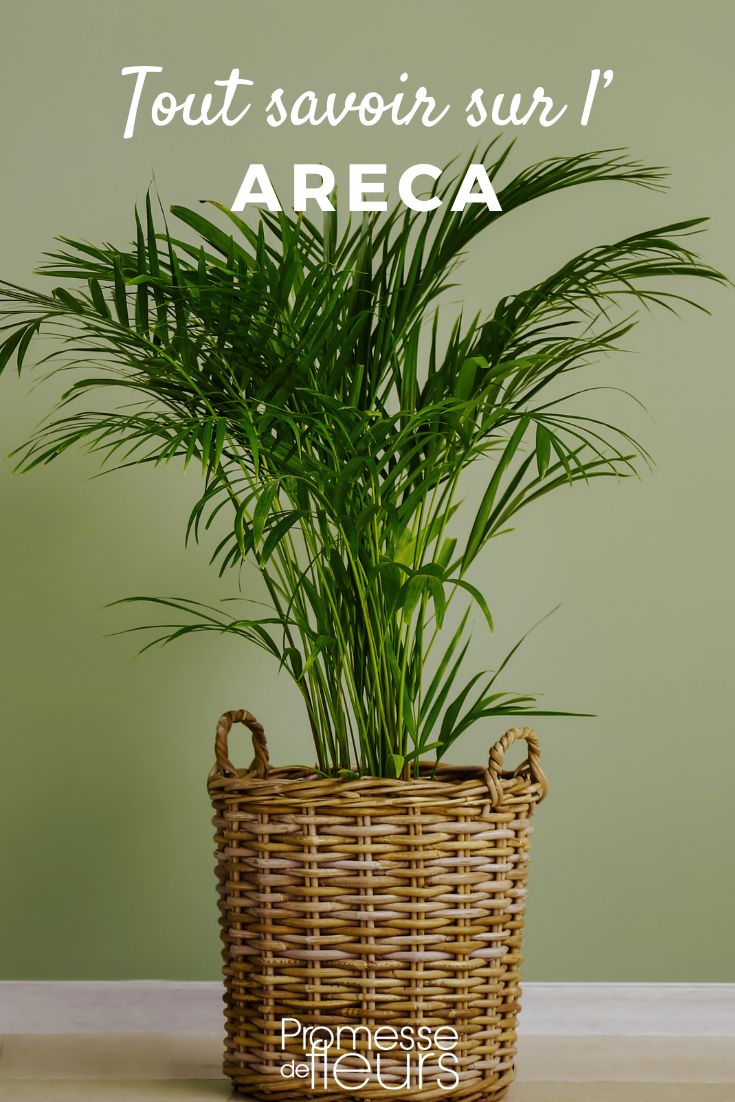































Comments